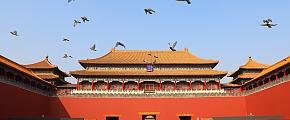Beijing Drum and Bell Towers
Located north of Coal Hill on Beijing's Imperial Road, the central axis of the city, are the magnificent Drum (Gulou) and Bell (Zhonglou) Towers. These ancient landmarks were an indispensable part of people's daily lives. The Drum and Bell Towers are built on a north-south axis separated by a small bustling square which has been a flourishing commercial area for over 700 years. The two ancient towers are built in classical Chinese imperial style that you should not miss in your Beijing tours. Each is different in appearance, and although similar in function, how they work is quite different.
Used during the Yuan (1271-1368), Ming (1368-1911), and Qing (1644-1911) Dynasties, the Drum and Bell Towers functioned as ancient Beijing's timekeepers. They set the pace and rhythm of daily life for everyone, from the emperor to the common citizen. The Drum tower's drums were used to keep time at night, while the Bell Tower's bells kept time during the day. The acoustics of the Drum and Bell Towers was so good that the drums and bells could be heard throughout the ancient city of Beijing. Beginning at 7:00 pm the drums in the Drum Tower were beaten every two hours through the night until 7:00 am. The towers were used for centuries until 1924 when they stopped being used. Many people could by that point own their clocks and the Drum and Bell Towers were considered outdated concepts.
Originally built in 1273 and located 100 meters south of the Bell Tower, Beijing's Drum Tower is one of the oldest buildings in Beijing. The Drum Tower is built on a 4-meter-high stone foundation with a wooden structure built on top. The entire structure is 46.7 meters high. The Drum Tower is a two-story building. Entry to the second floor of the Drum Tower is granted from a small doorway at the rear of the structure. Stone stairs lead visitors up to the upper floor where 25 drums are arranged around the wall surrounding one giant drum measuring two meters in diameter. At 7:00 pm the drums were beaten quickly 18 times then slowly 18 times. It was beaten in cycles until it was beaten a total of 108 times. This announces the beginning of the night watches. The drums were beaten every two hours which not only announced the time but also the change of the guards in the city.
The Bell Tower originally built at the same time as the Drum Tower was burned down in the Mid-Qing Dynasty and rebuilt. The Bell Tower was rebuilt of bricks and stones to prevent possible future fire damage. The structure has two floors and there are one large arched opening and two doors on all four sides of the second floor to allow the sound to travel throughout Beijing. Hanging on a large wooden frame on the second floor is the Bell Tower's namesake, a giant bronze bell. The bell is the largest and heaviest bell in China. It weighs 63 tons and is over seven meters high. The bell was rung by being struck by a two-meter-long log hanging from chains and is rumored to be heard for over 20 kilometers.
Resting quietly for the better part of a century, the Drum Tower was brought back to life on New Year's Eve of 2001. Since then, the drum is beaten every New Year's Eve. The drum is beaten 108 times. The giant bell in the Bell Tower remains silent, however. Visitors climbing the Bell and Drum Towers are greeted with spectacular views of Beijing's famous Hutongs. One of the most popular Hutong areas surrounds the two towers.
Contact us for a tailor-made Beijing tour incl. Bell and Drum Towers!
Related Posts You May Like
What Our Clients Say
"Great Customized Service", "Trip of A Lifetime", "Exceed All Expectations"



